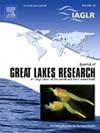Role of tributary cyanobacterial and nutrient transport and sediment processes on cyanobacterial bloom initiation in Lake Superior nearshore
IF 2.5
3区 环境科学与生态学
Q3 ENVIRONMENTAL SCIENCES
引用次数: 0
Abstract
Watershed fluxes of suspended sediment (SS), nutrients, in particular phosphorus (P), and cyanobacteria may play a role in driving cyanobacterial blooms along the southwestern shore of oligotrophic Lake Superior. To understand how tributary loads contribute to nearshore blooms, we sampled two southwestern shore tributaries, Bois Brule and Siskiwit Rivers. We collected water-quality samples to compute nutrient and sediment loads and to assess cyanobacteria community composition from the tributaries to the nearshore. We collected suspended and streambed sediment to assess the capacity for sediment to store and transport bioavailable P and to assess cyanobacteria community composition. Storm flows drove export of SS, total P, and total nitrogen, with the majority of total P being particulate P. Equilibrium P concentrations revealed that SS sorbed P as it is moved through the stream network across sites and seasons and was a potential source of P to the nearshore. However, streambed sediment in the Bois Brule and Siskiwit River watersheds were P sinks during summer, which potentially delayed transport of dissolved P to the lake. The cyanobacteria community varied spatially and temporally relating to multiple environmental variables including nutrients (P, N, and C) and specific conductivity. Cyanobacteria capable of producing cyanotoxins were present in tributaries and found across multiple environmental compartments indicating a potential for fluvial flow to the nearshore. This study demonstrated that streamflow is a primary driver of total nutrient and sediment loading in both watersheds, which indicates the potential for algal loading to the nearshore via suspended sediment or water.
苏必利尔湖近岸支流蓝藻和营养物运输及沉积过程对蓝藻华形成的作用
悬浮物(SS)、营养物(特别是磷(P))和蓝藻的流域通量可能在驱动贫营养苏必利尔湖西南岸的蓝藻华中发挥作用。为了了解支流负荷对近岸水华的影响,我们对两条西南海岸支流——布瓦布鲁尔河和西斯基威特河进行了采样。我们收集了水质样本来计算营养物和沉积物负荷,并评估从支流到近岸的蓝藻群落组成。我们收集了悬浮物和河床沉积物,以评估沉积物储存和运输生物有效磷的能力,并评估蓝藻群落组成。暴雨流驱动了总磷、总磷和总氮的输出,其中大部分总磷是颗粒磷。平衡磷浓度表明,SS在跨站点和季节的水系网络中吸收了磷,是近岸磷的潜在来源。然而,Bois Brule和Siskiwit河流域的河床沉积物在夏季是磷汇,这可能会延迟溶解磷向湖泊的输送。蓝藻群落的时空变化与多种环境变量有关,包括养分(P、N、C)和比电导率。能够产生蓝藻毒素的蓝藻存在于支流中,并在多个环境隔间中发现,这表明河流可能流向近岸。该研究表明,水流是两个流域总养分和沉积物负荷的主要驱动因素,这表明藻类可能通过悬浮沉积物或水向近岸负荷。
本文章由计算机程序翻译,如有差异,请以英文原文为准。
求助全文
约1分钟内获得全文
求助全文
来源期刊

Journal of Great Lakes Research
生物-海洋与淡水生物学
CiteScore
5.10
自引率
13.60%
发文量
178
审稿时长
6 months
期刊介绍:
Published six times per year, the Journal of Great Lakes Research is multidisciplinary in its coverage, publishing manuscripts on a wide range of theoretical and applied topics in the natural science fields of biology, chemistry, physics, geology, as well as social sciences of the large lakes of the world and their watersheds. Large lakes generally are considered as those lakes which have a mean surface area of >500 km2 (see Herdendorf, C.E. 1982. Large lakes of the world. J. Great Lakes Res. 8:379-412, for examples), although smaller lakes may be considered, especially if they are very deep. We also welcome contributions on saline lakes and research on estuarine waters where the results have application to large lakes.
 求助内容:
求助内容: 应助结果提醒方式:
应助结果提醒方式:


